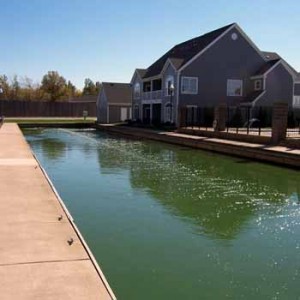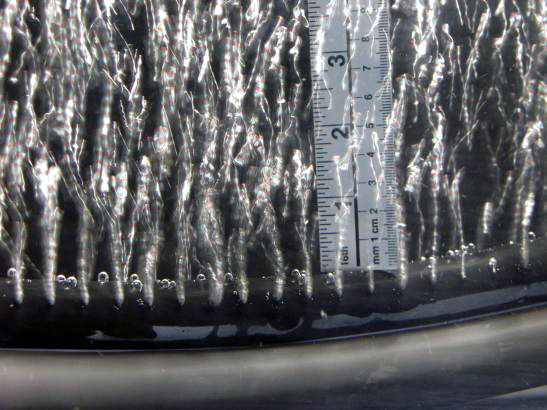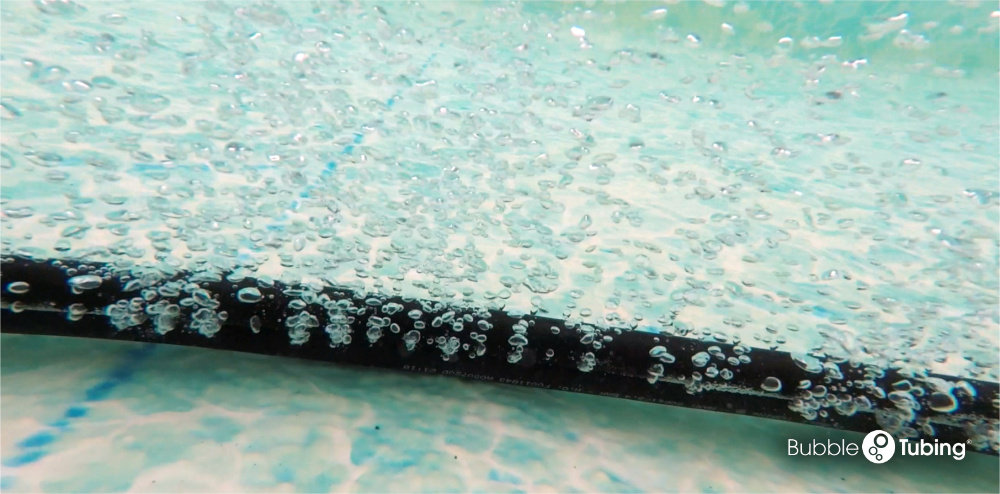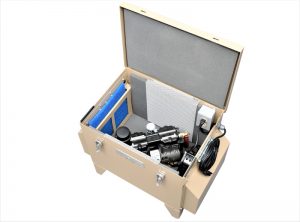Municipalities: What Can Bubbles And Bacteria Do For You?
The combined partnership of beneficial microorganisms, specifically bacteria and aeration, can treat some severe water quality problems quickly and successfully, saving municipal government money in associated treatment costs. Rising energy costs offer municipalities a good incentive to re-evaluate existing water treatment systems for efficiency in light of improvements to industry standards.
Water Quality Problems Canadian Municipalities Deal With
From recreational ponds in urban areas polluted with excess nitrogen from water fowl, to neighbourhood storm water retention basins full of green algae, to waste water treatment plants experiencing corrosion and grease build up, to composting projects managing effluents; all seek effective solutions that are cost efficient and sustainable.
The combined effects of aeration and beneficial bacteria can help reduce soluble nutrient loads, eliminate excess lake bottom sediments, reduce excess grease build-up, improve oxygen transfer rates, reduce noxious odours, improve effluent quality and reduce energy consumption by improving system efficiency in many types of water bodies. Bubbles and bacteria combine to use natural systems to combat modern problems, but occasionally these systems themselves require a review to see if they are functioning efficiently and doing what they were designed for. The following is a discussion on aeration system components and beneficial bacteria that may be useful for municipal water managers.
Aeration
 Aeration is a tried and true technology, proven effective around the world to add precious oxygen to a water body. In water treatment, the goal is to transfer a part of the 21% of oxygen found in ambient air to the bottom sediment level where it disperses via bubbles into the water column while scrubbing out accumulated noxious gases at the same time. For improving any aquatic environment, dissolved oxygen in water is critical to keep the treatment process aerobic; nutrient consuming microorganisms like bacteria thrive in aerobic environments. The various aerobic biological treatment processes commonly used today, including activated sludge, trickling filters, oxidation ponds, etc.; operate on the same fundamental principles of combining oxygen with bacteria. They differ primarily by their methods of oxygen transfer.
Aeration is a tried and true technology, proven effective around the world to add precious oxygen to a water body. In water treatment, the goal is to transfer a part of the 21% of oxygen found in ambient air to the bottom sediment level where it disperses via bubbles into the water column while scrubbing out accumulated noxious gases at the same time. For improving any aquatic environment, dissolved oxygen in water is critical to keep the treatment process aerobic; nutrient consuming microorganisms like bacteria thrive in aerobic environments. The various aerobic biological treatment processes commonly used today, including activated sludge, trickling filters, oxidation ponds, etc.; operate on the same fundamental principles of combining oxygen with bacteria. They differ primarily by their methods of oxygen transfer.
Aeration systems either treat the surface waters or the bottom waters. Surface aeration agitates the water by various mechanical means (e.g., propellers, blades, or brushes) to introduce air from the atmosphere. Bottom aeration, more discussed in this article, injects compressed air by diffusers or other devices submerged in the water body, usually from the basin floor. Surface aeration is considered less efficient as a means of oxygen transfer, as only the first few feet are treated, whereas in bottom aeration, the bubbles have time to move up and transfer oxygen throughout the depth of the water column. Surface aeration technologies create a strong movement of water whereas bottom aeration primarily moves air, which requires much less energy due to the large difference of density between air and water. In some applications where fish are involved and water temperature must remain stratified, surface aeration may be more appropriate. However the question to ask is whether the existing system is designed properly for the desired outcomes; if the goal is to maximize oxygen transfer rates, does water need to be agitated at the surface? Or will allowing bubbles to rise gently through the water column in an energy efficient manner suffice?
Bubble Size


Bubbles have some intriguing properties including gaseous exchange with surrounding fluids, turbulence generation to mix the fluids, and an ability to affect a fluid’s properties. Rising bubbles will draw bottom water up through the water column and will find itself in contact with the ambient air where further gas exchange is achieved. Rising bubbles that break the surface tension allow for the releasing of bottom gases created by the decomposition of organic sediments.
The air diffusion system determines the bubble size, which is a very important factor. Since the energy crisis in the early 1970s, there has been increased interest in fine pore diffusion of air as a competitive system due to its high oxygen transfer efficiency (OTE).
The micro-bubble creating technology used in the Bubble Tubing® and other diffusers allow higher oxygen transfer rates (OTR’s) since millions of tiny bubbles take more time to escape from the water body and have a much greater surface area for the same total volume, resulting in a greater OTR. Opting for micro-bubble technology may improve the OTR in an existing system. Delivering these precious bubbles takes an aeration system that is worth evaluating carefully.
The components of any aeration system include: the compressor, the compressed air delivery tubing and the aeration tubing or disc diffusers. There are great improvements to all of these components, making aeration today more efficient than ever before!
Compressors
 There is a wide range of compressors that operate using many different technologies and energy sources. Compressor size, noise level, energy consumption, maintenance regime, set up and efficiency vary greatly. Piston compressors are the most common machines available on the market, followed by the rotary claw compressors and the rotary sliding vanes compressors, all air positive displacement technologies. Matching the compressor type and size to the application alone can save your operation thousands of dollars in energy costs per year.
There is a wide range of compressors that operate using many different technologies and energy sources. Compressor size, noise level, energy consumption, maintenance regime, set up and efficiency vary greatly. Piston compressors are the most common machines available on the market, followed by the rotary claw compressors and the rotary sliding vanes compressors, all air positive displacement technologies. Matching the compressor type and size to the application alone can save your operation thousands of dollars in energy costs per year.
Recently, a small municipal waste water treatment facility responsible for aerating leachate effluent with a system designed in the 1970’s decided to evaluate their entire set up, since energy costs for running the system were an astronomical $60,000 per year. An evaluation survey found the compressor system was much too large for the application. The system combined surface aeration with air injectors resulting in oxygen transfer rates much lower than desired. In conjunction with an independent study collecting data from one basin at a time, they replaced the existing compressor with two energy efficient oil-less piston compressors and they changed the air delivery system to a system using state of the art bottom line Bubble Tubing®. Operational costs for the new system are expected to be around $10,000 per year. The new set up will pay for itself in less than a year from operational cost savings, and the OTR’s are exceeding previous standards. This is just one example of better technology available.
Air-Delivering Tubing
The tubing that delivers the compressed air to the diffuser should also be selected and sized properly for the job. If tubing is improperly sized, critical pressure may be lost or cause excessive wear in the compressor due to back pressure, reducing efficiency of the system. Aeration tubing should be self-sinking, durable, flexible (non-kinking), capable to withstand temperature changes, easy to install and be lead free. For system efficiency, tubing should be inspected every year as part of a regular maintenance regime.
Diffusing Devices
 Compressed air can be injected through various types or media to create micro-bubbles. It can be weighted linear Bubble Tubing®, which has micro-holes perforated along two sides of the tubing, or flexible rubber discs, air “stones” or Aero-Tube diffuser bases. These diffusers release thousands of micro-bubbles that rise to the surface.
Compressed air can be injected through various types or media to create micro-bubbles. It can be weighted linear Bubble Tubing®, which has micro-holes perforated along two sides of the tubing, or flexible rubber discs, air “stones” or Aero-Tube diffuser bases. These diffusers release thousands of micro-bubbles that rise to the surface.
The Bubble Tubing® was initially designed by a Canadian company to service aeration needs in shallow applications, although it is also very effective in deep water applications. It is flexible, weighted and can form any shape along any basin line. This makes installation very easy compared to air diffuser discs which need to be weighted in order to remain at the bottom. This technology is excellent for deep, steep applications where very high pressure is required. Because the linear Bubble Tubing® is more durable, it will outlast air diffuser discs and Aero-Tube diffusers. The air stones are common in aquariums, water gardens and smaller aeration projects. Many are still used in municipal projects even if they require more regular maintenance due to clogging.
Beneficial Bacteria
Fish and plants are not the only organisms living in the very complex aquatic ecosystems. Microorganisms which inhabit these systems include bacteria, fungi, algae, protozoa, rotifers, and higher forms. A balanced community of microbial bacteria is the basis of the natural purification of polluted waters. Beneficial bacteria are safely used in many industries as an active ingredient to create yogurt, cheese, beer, wine and, in agriculture, bacteria are employed to improve enzyme action at the root level.
Many municipal projects with the highest success rates in sediment reduction, water clarity, reduction of soluble nutrients and odours, are those that combine aeration with bacteria.
In waste water treatment systems, bacteria break down excess nutrients or sediments that contribute to algae growth, noxious odours, sludge accumulation and turbidity. Just as people take yogurt for its ability to assure the presence of the optimal community for digestion and immunity, a municipality can add liquid or dry beneficial bacteria to improve an aquatic ecosystem’s ability to manage excess nutrients.
 Certain bacteria are experts in breaking down plant cellulose into carbon dioxide, others aid in the removal of suspended solids by bacteria that secrete specific enzymes, and others still can reduce toxicity of pollutants or biodegrade agricultural wastes. Naturally, some bacteria thrive in aerobic or anaerobic conditions. For some that are experts in decomposition of accumulated organic sediments, aerobic conditions are desirable and for this reason, many municipal projects with the highest success rates in sediment reduction, water clarity, reduction of soluble nutrients and odours, are those that combine aeration with bacteria.
Certain bacteria are experts in breaking down plant cellulose into carbon dioxide, others aid in the removal of suspended solids by bacteria that secrete specific enzymes, and others still can reduce toxicity of pollutants or biodegrade agricultural wastes. Naturally, some bacteria thrive in aerobic or anaerobic conditions. For some that are experts in decomposition of accumulated organic sediments, aerobic conditions are desirable and for this reason, many municipal projects with the highest success rates in sediment reduction, water clarity, reduction of soluble nutrients and odours, are those that combine aeration with bacteria.
Municipalities will hire aeration specialists to review existing systems and procedures or do the work internally. Research and expert advice can help you chose the best bacteria product or combination for a particular problem, as well as helping you decide on the best treatment regime.
Partnerships can often be more beneficial than solo endeavours; bubbles and bacteria combined may be the answer to help municipalities improve water quality safely and effectively for many applications, while improving treatment efficiency and reducing operational costs.